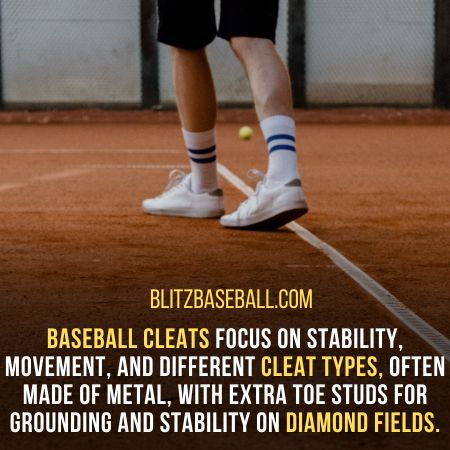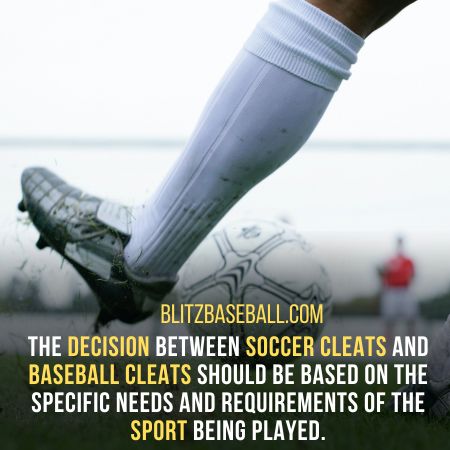Soccer cleats vs baseball cleats are essential pieces of equipment that cater to the specific needs of each sport. While soccer cleats are designed for running and ankle support, baseball cleats prioritize stability and movement on diamond fields.
This article provides an in-depth analysis of the differences between soccer cleats and baseball cleats, focusing on their game requirements, suitability for different fields, design, and material variations.
By understanding these distinctions, athletes, and coaches can make informed decisions when selecting the appropriate cleats for their respective sports.
The article aims to provide a comprehensive overview of the unique features and functionalities of soccer cleats and baseball cleats, emphasizing the importance of using the right cleats for optimal performance and injury prevention.
By adhering to the specific requirements of each sport, athletes can maximize their potential and excel in their chosen discipline.
Key Takeaways
- Soccer cleats and baseball cleats are designed for different sports and have specific features to cater to the needs of each sport.
- Soccer cleats prioritize lightweight design, ankle support, and spikes in the midsole for running and agility on soccer fields.
- Baseball cleats focus on stability, movement, and different cleat types, often made of metal, with extra toe studs for grounding and stability on diamond fields.
- It is important to use the appropriate cleats for each sport to ensure safety, performance, and adherence to the rules of the game.
Soccer Cleats Vs Baseball Cleats

Different Game Requirements
Soccer and baseball, being fundamentally different games, have distinct requirements when it comes to the type of cleats needed for optimal performance.
In soccer, ankle support is important, but player mobility and freedom of movement are prioritized. Soccer cleats are designed with lightweight materials such as rubber or plastic, providing both agility and ankle support.
On the other hand, baseball cleats prioritize stability and movement. They are often made of metal or rubber, with different cleat types for grounding and stability. Ankle support is also crucial in baseball due to different running motions and rules.
Moreover, sports lovers prefer baseball over soccer.
The weight and design of the spikes in baseball cleats affect player mobility and stability. Therefore, it is essential to use the appropriate cleats for each sport to ensure safety and enhance performance on the field.
Suitability for Different Fields
When considering the suitability of different fields, it is important to take into account the specific requirements and design of the playing surface. Safety concerns on the wrong field can arise if the appropriate cleats are not worn.
Using soccer cleats on a baseball field can be dangerous due to the metal spikes designed for baseball cleats.
The metal spikes can cause injury to players on the soccer field. Similarly, using baseball cleats on a soccer field can also pose safety risks as the metal spikes can damage the turf and potentially cause injury to other players.
Moreover, wearing the wrong cleats can impact player performance and increase the risk of injury. Soccer cleats provide the necessary traction and support for quick movements on grass surfaces, while baseball cleats offer stability and grip on the diamond field.
Therefore, it is crucial for players to use the appropriate cleats for each sport and field to ensure safety and optimize performance.
Design and Material Differences
The design and material differences between soccer and baseball cleats contribute to their suitability for specific sports and playing surfaces.
Cleat construction plays a vital role in determining the performance and functionality of the cleats in each sport.
Soccer cleats are typically lightweight and made of rubber or plastic, allowing for quick movements and agility on the soccer field. They have spikes in the midsole that provide traction on the grass.
In contrast, baseball cleats prioritize stability and movement, often made of metal or rubber. They have different types of cleats, including extra toe studs for grounding and stability.

The heavier weight of baseball cleats helps players maintain balance and support during lateral movements on the diamond field.
These design and material differences ensure that soccer cleats and baseball cleats are not interchangeable and are tailored to the specific needs of each sport.
Choosing the Right Cleats
One important factor to consider is the specific playing surface when choosing the appropriate footwear for a sport. When it comes to choosing between soccer cleats and baseball cleats, players need to consider the durability and comfort of the cleats, as well as the price comparison.

-
Soccer cleats are generally more durable than baseball cleats due to the materials used, such as rubber or plastic. They are designed to withstand the demands of running and provide ankle support.
-
Baseball cleats prioritize comfort, often using cushioned midsoles and padded tongues for added comfort during long games.
-
In terms of price, soccer cleats are generally more cost-effective, making them a popular choice for practice sessions.
-
Baseball cleats, on the other hand, tend to be more expensive due to their specialized design and materials.
-
Ultimately, the decision between soccer cleats and baseball cleats should be based on the specific needs and requirements of the sport being played.
